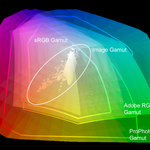- Home
- Color Management
- Discussions
- When to use process and spot colors together?
- When to use process and spot colors together?
When to use process and spot colors together?
Copy link to clipboard
Copied
I'm Graphic design student and I have a qeustion for the color management. When I use spot color in illustrator, how can I bring it into InDesign? InDesign color panel doesn't support spot color that I was looking for and when do we need to use process and spot colors at the same time?
Copy link to clipboard
Copied
My opinion - I think 'spot colours' are much misunderstood.
It's perfectly OK to communicate colour for design between users by referring to a number from a swatch-book, like 'Pantone'. Instead of saying, e.g. "sky blue" a term which is very open to misinterpretation.
But, the Pantone system is actually all about mixing up special Pantone inks to specific formula in the press room and using those "special colours" in an extra unit on the press.
If you want, say, IBM blue, then it’s a specially mixed ink.
So it that means it might be a "5 colour print job", C+M+Y+K+spot
If you or your client are not paying for a "special" colour on the press run then your "spot colour" will be created out of the CMYK "process" inks. And (very) often that will not match your expectations.
More here: https://graphicdesign.stackexchange.com/questions/172/what-is-5-colour-printing
You can get Pantone 'process colour' swatch-books, but no one seems to know what CMYK ICC profiles were used in the calculations therein, which seem to me to make them pretty much useless.
I'm sure experienced designers will chip in here about whether they get better results by using Lab colour** definition or maybe RGB. It's hard to sue CMYK mixes if you don't know the ICC profile of the press that will print your job.
SO sad that students get virtually zero colour management training it seems
* Lab colour [more correctly L*a*b* colour] is used throughout Adobe applications as a basis for colour management - Lab provides an entirely unequivocal definition of colour.
Why not look it up, [start here: https://helpx.adobe.com/uk/illustrator/using/color.html ]
I hope this helps
neil barstow, colourmanagement net :: adobe forum volunteer
google me "neil barstow colourmanagement" for lots of free articles on colour management
[please only use the blue reply button at the top of the page, this maintains the original thread title and chronological order of posts]
Copy link to clipboard
Copied
CMYK is four inks, which printers (the companies who print things) buy in buckets. Each spot colour comes in another bucket. So it's entirely possible to print with multiple spot colours, or CMYK without one or more spot colours - provided the printer has room for that many ink buckets, and provided they have ordered those buckets, and you are willing to pay. This is not something for designers to use on a whim, it is a decision to make based on a detailed discussion of client needs, client budget, and printer's abilities. Many designers are not tought that wrongly using spot colours in their design can cause expensive disasters - until they get the blame for work being late or mis-printed. Getting a print run of several million wrong does really focus the attention after that!
Copy link to clipboard
Copied
It's important to understand the spot PMS colour can only be used for things like headings and colour panels they can't be used to extend the gamut of CMYK. The only way you can extend the gamut of CMYK is to use Inkjet printers that have extended colour cartridges typically nine colours.
(As a student learn about soft proofing.)
Copy link to clipboard
Copied
Process colors can be used to represent images and designs but are limited by their gamut and the fact they must be screened into dots to be printed. This screening process can become a problem if the color is used on fine type or even large areas of color in a design.
Using spot colors provides the ability to print a solid color in the place of a screened build of 4 color process. These solid areas normally print better and are easier to read in the case of fine type.
Spot colors are also used to print colors outside the gamut of 4 color process. So for example if you look at a Pantone Plue color book with CMYK matches next to the PMS color you will notice that many colors can not be closely matched in 4 color process. In which case a PMS color can be used, but be aware that if the design contains 4 color images there will be an additional ink and unit on the pross whic is additional cost.
Spot colors can also be used to add gamut to 4 color process or create a special look and feel to images.


